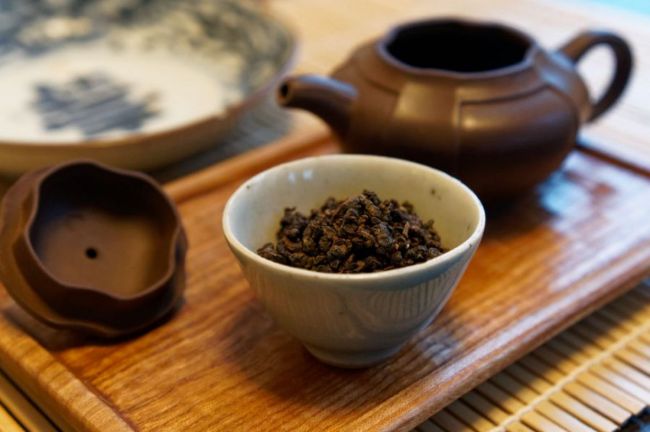
Since oolong is such a broad category of tea, the amount of caffeine can vary quite a bit. However, it generally contains 37-55 mg of caffeine per 250ml, which is approximately half the amount found in coffee.
What is oolong tea?
Oolong tea (烏龍) is a traditional Chinese style of tea which is somewhere in between green and black tea in terms of its oxidation level. Depending on how the tea is processed, some oolong teas can present themselves as almost like a green tea, whereas on the opposite side of the spectrum, they can also be very similar to a red tea (black tea).
This type of tea is known for having a wide array of flavors and a strong floral aroma, sometimes with notes of honey, apricot, or orchid, although the flavor profile can vary drastically.
When it comes to brewing, it can sometimes require a little more skill to bring out the full potential of oolong tea. This is particularly true when brewing darker varieties of oolong. While lighter oolongs can still be tricky, they are often a bit more forgiving.
Although the category of oolong tea may seem a little intimidating at first, it is also a very rewarding and diverse category of tea with a lot to choose from.
“Looking deeply into your tea, you see that you are drinking fragrant plants that are the gift of Mother Earth. You see the labor of the tea pickers; you see the luscious tea fields and plantations in Sri Lanka, China, and Vietnam. You know that you are drinking a cloud; you are drinking the rain. The tea contains the whole universe.”
– Thich Nhat Hanh
Factors that influence caffeine levels in tea
There are quite a few factors which can influence the caffeine content of oolong tea and we will discuss some of them in the text below.
Tea cultivar
Specific tea cultivars can contain different levels of caffeine, so it suffices to say that different types of oolong tea can contain different levels of caffeine.
Region and terroir
Tea is grown in many regions of the world, including in many different areas of China, all of which have unique terroirs and growing conditions. The altitude, soil, climate, and amount of cloud-cover can immensely influence the level of caffeine and other compounds in the final product.
Of course, the amount of care that went into growing the tea, as well as natural variation, are also contributing factors.
Time of harvest
The time of harvest is another important aspect to consider.
Generally, younger tea which is harvested earlier in the year is thought to be more potent.
Processing
Processing techniques can also play a role in how much caffeine ends up in your cup of tea.
For example, tea which is cut, crushed, or torn will likely brew a stronger cup of tea than if the same tea were to be processed as whole leaves.
Brewing parameters
The brewing parameters are probably the most important thing to keep in mind.
How much tea is added is of course the most crucial factor. However, the water temperature and steep time are also deciding factors. Typically, the hotter the water and the longer the steep time, the more caffeine will be extracted.
Where to get Oolong tea?
We have a wide selection of of oolong tea available. Buy oolong tea here.
Hugs,
Admar
.png)

